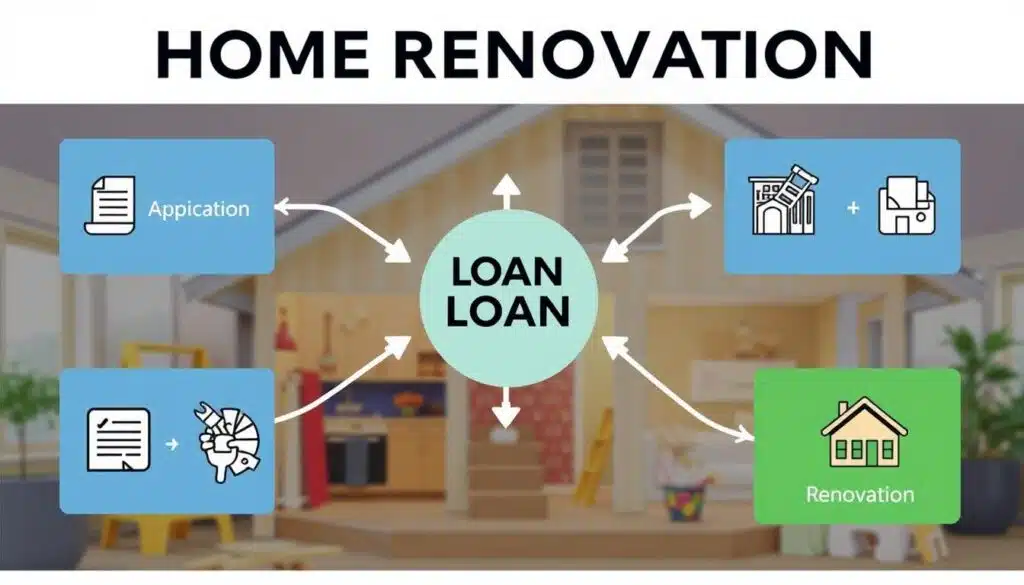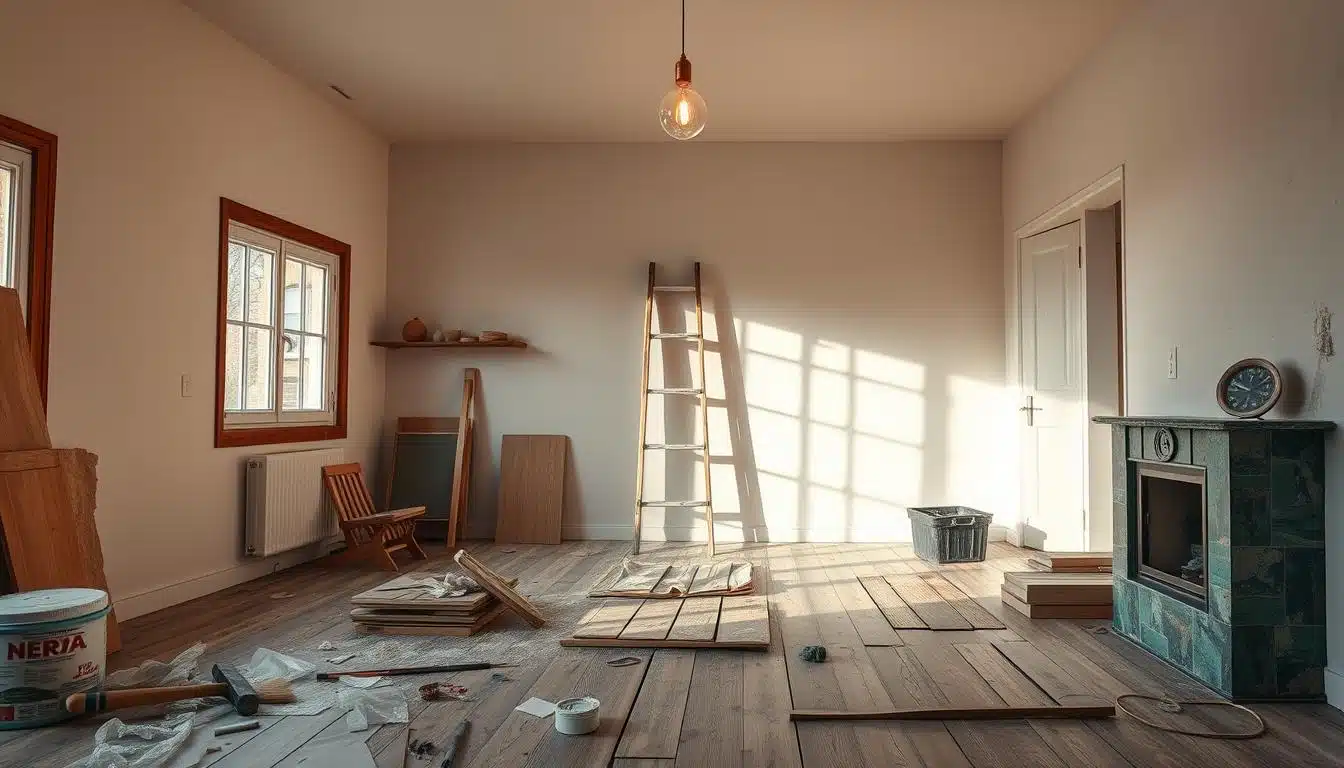Loan For Renovation Starting a home renovation project is thrilling, but it needs smart financial planning. The first step is figuring out how to pay for your improvements. Homeowners have many options, like home equity loans, lines of credit, and personal loans. We’ll look at these choices, the application process, and what to think about when picking the right loan for your renovation.
Key Takeaways
- Understand the various financing options for home renovations, including home equity loans, home equity lines of credit, and personal loans.
- Evaluate the loan amount and repayment terms that fit your budget and renovation plans.
- Prepare for the loan application process by gathering necessary documents and understanding the requirements.
- Consider the return on investment (ROI) and long-term impact of your home renovation project.
- Explore opportunities to save money, such as completing some projects yourself or negotiating with contractors.
Exploring Different Financing Options for Home Renovations
When planning your home renovation, you have many financing options. Home equity loans and lines of credit and personal loans are popular choices. Each has its own benefits and things to consider.
Home Equity Loans and Lines of Credit
Using your home’s equity for renovations can be wise. A home equity loan is a second mortgage with a lower interest rate. A home equity line of credit (HELOC) lets you borrow as needed, up to a limit.
Home equity loans and lines offer tax-deductible interest and large funding. But, remember, your home is at risk if you can’t repay the loan.
Personal Loans
Personal loans are another option for renovations. They don’t require collateral, making them straightforward. Personal loans have fixed rates and predictable payments.
Personal loans might have higher rates than home equity options. They’re great for smaller projects or if you lack home equity. The application process is also quicker.
The best financing for your renovation depends on your needs and finances. Weigh each option’s pros and cons. Choose what fits your goals and financial future.
Loan For Renovation: Understanding the Process

Getting a loan for your home renovation is easy. You might look into home equity loans, personal loans, or renovation loans. Knowing the steps can make the process smoother.
First, figure out what you want to do and how much it will cost. This helps you know how much money you need. Lenders check your credit score to decide on loan terms. So, it’s good to check your credit and fix any problems before you apply.
- Gather necessary documents, such as a valid ID, proof of income, and project estimates.
- Get pre-qualified with multiple lenders to compare loan offers and find the best terms for your renovation loan.
- Understand the loan requirements, including any collateral or down payment needed, to ensure a smooth application process.
A renovation loan is a type of financing for home improvements. You can choose from home equity loans, refinance, or renovation loans. Knowing the process helps you find the right loan for your project.
| Loan Type | Key Features | Pros | Cons |
|---|---|---|---|
| Home Equity Loan | Borrow against the equity in your home | Lower interest rates, fixed monthly payments | Requires home equity, can put your home at risk |
| Personal Loan | Unsecured loan based on your creditworthiness | Flexible use, faster approval process | Higher interest rates, shorter repayment terms |
| Renovation Loan | Specialized loan for home improvement projects | Designed for renovations, may include project funds | Stricter eligibility requirements, potential for higher costs |
“A well-planned home renovation can significantly increase the value of your property, making it a smart investment in the long run.”
Factors to Consider When Choosing a Loan for Home Renovations

When picking a loan for your home makeover, think about a few key things. The loan amount and repayment terms are very important. They affect how much your renovation will cost and if it’s doable.
Loan Amount and Repayment Terms
The loan amount you can get depends on your home’s value, your current mortgage, and how much equity you have. Lenders usually let you borrow 80-90% of your home’s value, minus your mortgage. This loan program can help fund your home improvement project.
The loan term is also crucial. A longer term means smaller monthly payments but more interest over time. A shorter term means bigger payments but less interest.
| Loan Term | Monthly Payment | Total Interest Paid |
|---|---|---|
| 5 years | $1,000 | $3,000 |
| 10 years | $600 | $7,200 |
| 15 years | $450 | $12,000 |
Also, think about the type of loan, like fixed-rate or adjustable-rate. Look out for prepayment penalties or balloon payments. These can change the cost and affordability of your home renovation financing.
“Carefully evaluating the loan amount and repayment terms will help you make an informed decision and ensure your home renovation project is a success.”
Preparing for the Application Process

Getting the right loan for your home renovation is all about preparation. You’ll need to gather important documents and info. Start by getting a valid ID, like a driver’s license or passport. Also, collect proof of income, like pay stubs, tax returns, or bank statements.
Then, get detailed estimates for your renovation. This helps lenders figure out your home’s value and how much you can borrow. Talk to contractors or home experts to get accurate cost estimates for your renovation projects.
- Make a list of your current debts and loans, like credit cards, car payments, and mortgages. Lenders check your debt-to-income ratio to see if you qualify for a loan.
- Get pre-qualified with several lenders to compare loan offers. This helps you find the best deal for your home remodel. You’ll understand the loan limits and how long the loan will last.
By preparing well, you’re on your way to getting the perfect renovation loan. The application process will be smoother with all the right info and documents ready.
“A well-planned loan application can make all the difference in securing the ideal financing for your home renovation project.”
Also Read : How Creditworthiness Affects Your Financial Opportunities?
Conclusion
Home renovation projects can be a big investment. But, with the right financing, homeowners can make their homes better without risking their money. Options like home equity loans, lines of credit, personal loans, and cash-out refinancing are available for funding.
Choosing the right loan is key. You need to look at the loan amount, repayment terms, interest rates, and if you’ll use your home as collateral. Knowing the application process well can help you get the best credit and the perfect loan for your project.
Whether you want to live in the home for a long time or pay off the loan fast, there are options. By choosing wisely and focusing on what you need, you can make your home better. This way, you’ll enjoy the fruits of a successful renovation.
FAQs
Q: What is a renovation loan?
A: A renovation loan is a type of financing that allows homeowners to borrow money specifically for home improvement projects. It can cover renovation costs associated with remodeling, repairing, or upgrading a property.
Q: How does a home improvement loan differ from a traditional mortgage?
A: A home improvement loan is specifically designed to finance improvements on a property, whereas a traditional mortgage is primarily used to purchase a home. Some renovation loans can be incorporated into the mortgage itself.
Q: What are the different types of home renovation loans available?
A: Common types of home renovation loans include FHA loans, Homestyle renovation loans, and construction loans. Each loan option has its own eligibility criteria and financing terms.
Q: Can I get a renovation loan to buy a fixer-upper?
A: Yes, you can use certain renovation loans like FHA 203(k) or Homestyle loans to purchase a fixer-upper. These loans allow you to finance both the purchase price and renovation costs in one loan.
Q: What factors affect loan rates for home renovation loans?
A: Loan rates for home renovation loans are influenced by various factors, including your credit score, the value of your home, the type of renovation, and the overall economic environment.
Q: How do I apply for a home renovation loan?
A: To apply for a home renovation loan, you need to gather necessary documents such as proof of income, details about the renovation costs, and information about your existing mortgage. You can then approach a lender to discuss your loan options.
Q: Are there any restrictions on the type of renovations I can finance with a renovation loan?
A: Yes, most renovation loans have specific guidelines on the types of improvements that can be financed. Generally, structural changes, repairs, and upgrades that add value to your home are eligible, while luxury items or non-permanent improvements may not be.
Q: What is a home equity line of credit, and how does it relate to renovation loans?
A: A home equity line of credit (HELOC) allows you to borrow against the equity in your home. It can be used for home improvements, but it differs from renovation loans in that it typically operates like a credit card, offering flexibility in borrowing and repayment.
Q: What is the benefit of using a single loan for home purchase and renovation?
A: Using a single loan for both home purchase and renovation simplifies the financing process, reduces the number of loans you have to manage, and can often result in lower overall interest rates compared to taking out separate loans.
Q: Can I use a personal loan for home renovations?
A: Yes, you can use a personal loan for home renovations, but keep in mind that personal loans often have higher interest rates and shorter repayment terms compared to dedicated renovation loans.





